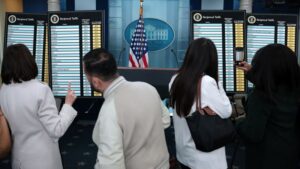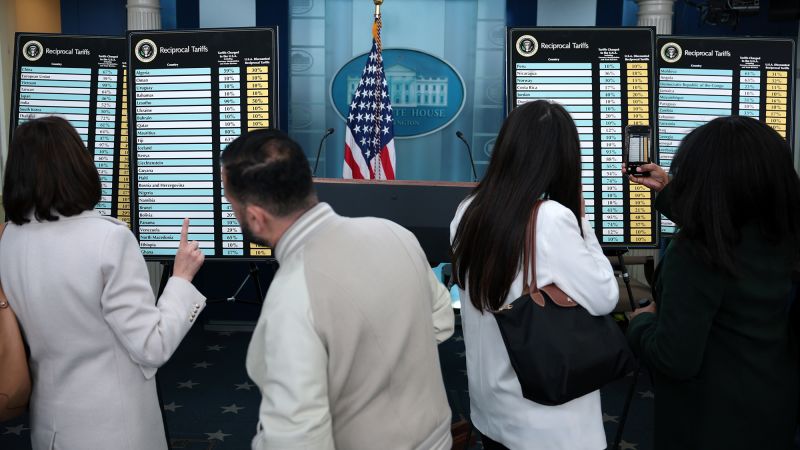In early April 2023, President Donald Trump heightened global economic tension by announcing a 90-day ultimatum for countries to negotiate trade agreements with the United States or face significant increases in tariffs. This deadline beckoned a multitude of consequences, with the impending deadline set for 12:01 a.m. ET on July 9, creating a palpable sense of uncertainty in the international finance arena. Such tariffs, intended to protect domestic industries, have left many speculating about their potential effects on global trade, the economy, and even investor sentiment.
With the stakes at such an astronomical level, economists around the world have sounded alarm bells, warning that an escalation in tariff rates could plunge not just individual nations into recession but may also trigger a worldwide economic downturn. On what Trump proclaimed as “Liberation Day” on April 2, the administration unveiled new, “reciprocal” tariffs that imposed rates as high as 50% on goods from several key trading partners. This marked a historic moment as the United States enacted some of the highest tariff rates on foreign products seen in over a century.
Following this announcement, the tariffs were rolled out on April 9, leading to an immediate backlash in the financial markets. A notable sell-off occurred on Wall Street, and the bond market exhibited panic that forced Trump to announce a temporary three-month reprieve for negotiations. The president acknowledged that investors were becoming increasingly anxious and “a little yippy,” which he interpreted as a justified fear stemming from the unpredictable nature of the negotiations.
During the pause, a minimum of 10% tariffs was imposed on nearly all imports into the U.S., posturing the market for potential volatility. However, despite this uncertainty, stock markets rebounded and reached multiple record highs, while inflation levels stayed relatively stable. Nevertheless, analysts are wary that if tariff rates resume their upward trend, they could trigger a surge in inflation that erases any economic gains achieved during the summer months.
As the new deadline approaches, the Trump administration has been meeting with international government representatives, suggesting that several deals may soon be finalized. However, only three trade agreements have been made public to date, one of which being a deal with Vietnam that remains without key details. Amid ongoing negotiations, the administration has adopted a strategic posture, threatening to penalize countries that fail to secure agreements by sending letters detailing newly proposed tax rates for exports to the U.S.
Trump’s communication indicates a willingness to revert to previously announced tariff rates if negotiations do not progress satisfactorily. However, the criteria for “good faith” negotiations and whether certain countries fall under such an understanding has remained unclear. The lack of clarity on these matters, compounded with Trump’s ambiguous positions, adds a layer of unpredictability to the global trade landscape.
In recent remarks, Trump suggested that he has significant leeway in crafting the future of U.S. trade policy, hinting at the possibility of imposing harsh tariffs of 25%, depending on how countries treat the U.S. This assertive stance includes the intention to categorize nations based on their reciprocal treatment toward the U.S., suggesting a tailored approach to tariffs that could see rates vary dramatically.
Trump detailed that the tariffs could range widely—as high as 60% to 70%, down to 10%—gearing towards an aggressive stance that could severely impact the economies of nations struggling to maintain trade ties. However, this aggressive tariff reiteration appears to be a calculated decision, leaving room for nations to negotiate and avoid such steep penalties prior to their actionable dates.
One of the primary agreements made was with Vietnam, which stipulates a minimum tariff rate of 20%, a doubling of rates during the temporary halt in negotiations. This figure, although steep, appears more favorable compared to the initial proposal of 46%, positioning it as a tactical victory in the ongoing trade war strategy.
Industry experts note that despite the continuance of tariff-related uncertainties, the Vietnam deal signals a potential for a more robust bilateral relationship. Ulrike Hoffmann-Burchardi, a prominent figure in global equities at UBS Global Wealth Management, regarded the deal positively, suggesting it could enhance clarity for investors moving forward.
Despite ongoing headwinds and uncertainties surrounding trade negotiations, Hoffman-Burchardi remains optimistic that the Trump administration will lean towards economic stability and restraint in forthcoming tariff implementations, particularly as the 2026 midterm elections draw near. This sentiment embodies the complexities of navigating the world’s largest economy while balancing the intricacies of global trade relations.











